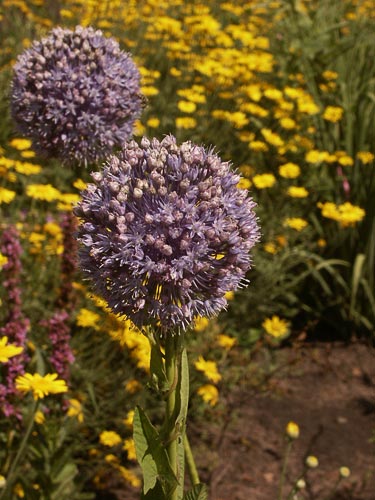Relatives
Allium caeruleum Pall. - Blue globe onion.
Taxonomic position.
Family Alliaceae J. Agardh genus Allium L.Synonyms.
Allium azureum Ledeb., A.viviparum Kar. et Kir.Morphology and biology.
Perennial, bulbous plant. Geophyte. Single bulb, 1-2 cm in diameter, globular-ovoid, with gray, filmy coating. The stem is 25-85 cm tall; one quarter of it is covered with either smooth or rough axils. Leaves, (2) 3-4 in number, are triquetrous, smooth, grooved, shorter than the stem. The umbel is hemispheric or spherical, dense, polyanthous, often with bulbils. Pedicels are equal in length, 2-5 times longer than the perianth, with bracts at their base. Sepals are 4-5 mm long, equal to one another in length, blue, with a dark vein, gently obtuse; the outer sepals are oblong-lanceolate; the inner ones are lanceolate. Filaments are equal in length or slightly longer than the sepals, broadening towards the base; the inner ones are a little wider at the base, sometimes with denticles. The stylus protrudes from the perianth. Autochore. Blossoms in June, bears fruit in July. Chromosome number: 2n = 16.Distribution.
Found in Southeastern European Russia, Western Siberia (south of Altai Region, Tyva), Kazakhstan (Near-Aral and Near-Balkhash areas, Saur, Tarbagatai), Middle Asia (Tien Shan, Altai Range, Mogian), and Dzungaria.Ecology.
Halophyte. Photophilous. Grows in solonetz soils and solonetz meadows; occurs in the steppe zone of the mountains.Utilization and economic value.
Wild relative of cultivated onions; promising for breeding.References:
Friesen, N.V. 1988. Onions plants of Siberia. Novosibirsk: Nauka, p.157 (in Russian).Malyshev L.I., Peshkova G.A., eds. 1987. Flora of Siberia. Araceae - Orchidaceae. V. 4. Novosibirsk: Nauka, pp.93-94 (in Russian).
Vvedensky, A.I. 1935. Onion - Allium L. (Flora of the USSR, vol. IV.) Leningrad: Publishing House of the USSR Academy of Sciences, pp.221-222 (in Russian).


